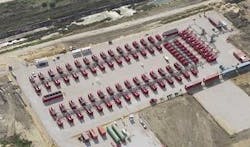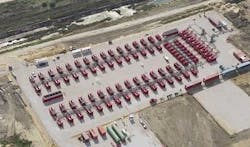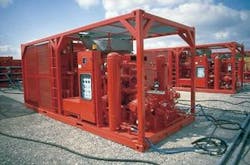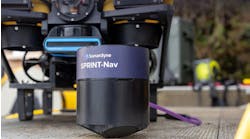Greenstream validates temporary compressors for deepwater pipeline projects
Single station renders wet-buckling contingency, dewatering/drying capabilities
Ross Coleman
Troy Dilzell
Weatherford International Ltd.
Technical evolution inevitably results in a domino effect for ancillary equipment and processes. The energy industry’s continued quest to drill and produce in more severe and remote conditions and environments is one example of this cause-and-effect scenario. The technological development that has allowed exploitation of oil and gas reserves in increasingly deeper waters also has forced construction companies to consider the “wet-buckle” situation and pipeline pre-commissioning operations for gas transportation pipelines.
Weatherford’s involvement in the Blue-stream pipeline project in the Black Sea presented a wealth of opportunities to design, enhance, and modify systems for a wet-buckle contingency and drying/pre-commissioning of deepwater pipelines. One of the results was the creation of the temporary air compression station (TACS) used for wet-buckle contingency and pipeline pre-commissioning operations of the twin 24-in. pipelines.
The experience and lessons learned with the TACS on Bluestream were translated into work Weatherford performed for the Trans-Mediterranean pipeline, known as Greenstream.
Setting the stage
The Bluestream water depth and the length of the pipeline effectively produced conditions during pipelay that contributed to potential problems such as wet buckling. This condition occurs when water floods the pipeline as it is laid. It results in significant construction delays and increased costs. Wet buckling is most likely to occur during deepwater installation. Although few deepwater projects ultimately require a wet buckle contingency during pipelay, the benefits of having one in place become obvious when compared to the costs incurred to correct the situation post-installation.
Once pipeline installation is complete, pre-commissioning activities follow. Regulators require hydrostatic testing for proving theintegrity of deepwater gas lines. Weatherford needed to dewater, clean, dry, and purge nitrogen to ready the pipeline to accept hydrocarbons. The company recognized that the facilities that provide a wet-buckle contingency could also be allocated for the required pre-commissioning operations before introducing hydrocarbons into the pipeline. In addition to assimilating these assumptions and conclusions into their approach, Weatherford realized that during the dewatering phase - or during water evacuation if needed for post wet-buckle recovery - they required additional equipment for overcoming the hydrostatic heads with deepwater pipelines.The major design criteria for Bluestream, Saipem SpA disclosed, focused on creating as small a footprint as possible and being fuel-efficient to meet detailed operational specifications, which included 64,000 scfm, 3,625 psig, -76° F dew point, and 0.001 ppm oil content. With objectives set and parameters established, Weatherford determined that its combination compressors design could adapt for pipeline use.
Installing the pipeline in these water depths posed a serious risk for wet buckling, and Weatherford specified a contingency at all times during the process. Weatherford provided sufficient compressed air capacity on site and on demand to displace water out of any flooded pipe spools to prevent wet buckling. This approach would enable retrieval of the pipe. Central to this proposal was the use of the same compression spread for dewatering and drying activities during pre-commissioning of the pipelines.
The company took advantage of systems already in place and used them for dual purposes to ensure efficiency. Although previously Weatherford used some elements of the proposed station individually, assembling them into one TACS presented unique challenges, from operating within severe budgetary constraints to delivering a complete system on a tight schedule to a remote location.
Temporary air compression station
The Bluestream solution ultimately saw the construction of a fully stand-alone compression station that incorporated 78 major components and required approximately 40% less space than conventional compressor units. The components consisted of 58 main combination compressors, four feed compressors, eight high-volume air dryers capable of dew points exceeding -76° F, and eight boosters. A Weatherford-engineered combination compressor unit consists of a rotary screw compressor and a horizontal reciprocating compressor, each capable of delivering 1,150 scfm at 2,000 psig. The entire station generates 52,500 bhp (brake horse power) on location. The eight high-pressure boosters, designed around a two-stage horizontal reciprocating compressor, provided an additional stage of compression to meet the 3,625-psig final discharge pressure. This overall design fulfilled Saipem’s requirement for a system with maximized fuel efficiency and minimized footprint.
Weatherford designed the main combination compressor. But, given the time constraints, the massive task of designing and building all the main compressor units, feed compressors, dryers, boosters, oil filtration units, and auxiliary components, the company had to delegate to an outside engineering team with strong experience in this area. SRC Engineers designed the station and ensured that all of the components operated not only individually, but also as a synergized unit to produce the required flow rates and pressures. Once engineering and construction details were finalized a common design specification, multiple companies fabricated the unit. The first key milestone in this innovative project function was the testing of the TACS on location.
With the formality of testing, delivery, and staging complete, pipelaying operations proceeded. TheSaipem 7000 took three to four months to J-lay each line, during which time the station was on standby and ready to operate within 72 hours of a wet-buckle incident. Six operations personnel were on location daily to maintain and run individual units every other day. During pipelay, the site received two call-outs for contingencies, both requiring the use of the station.
Station control, monitoring
Weatherford delegated the main compressor unit (above), along with feed compressors, dryers, boosters, oil filtration units, and auxiliary components, to SRC Engineers, an outside engineering team.
The advantage of the TACS lay not only in its conglomeration of individual parts operating as one unit, but also in its use of personnel. During the second call-out, the entire team mobilized within 24 hours. Twelve Russian team members, on site for maintenance duties, operated the station until the standby team arrived because the entire station was tied into the programmable logic controller (PLC).
Using an on-site PLC in a main station control room and unit PLCs on individual operating equipment enabled the equipment to be monitored and provided real-time data on engine parameters, injection line temperatures, flows, and pressures. Availability of real-time data contributed to improvements in Saipem’s flow-modeling program. The station PLC was critical to the operational success of the project both for Weatherford and Saipem. The system’s main function was to monitor all operating aspects of the station while minimizing personnel requirements and therefore, costs. The operations manager had immediate access to the information from a main control room, which expedited decisions and communication to the team. This integration of systems information and operations ensured no downtime during project operations and provided Saipem with critical data for improving future projects.
Pre-commissioning operations
With pipeline installation complete, Weatherford used its dual-purpose station to dewater and dry the Bluestream line before initiating gas flow. This commissioning operations step begins by flooding the line for hydrostatic pressure testing to 1.5 times its operating pressure. The test reveals leaks and poor welds and establishes value integrity. Once Weatherford tested the line and verified its integrity, the station started, and Weatherford launched the dewatering pig. This process expels all of the water from the entire line. Weatherford chose to use dry air in the dewatering operation to start the drying process, and Saipem decided to continue using dry air because of the inordinate amount of time needed to fill the volume of the pipeline from Russia to Turkey.
After dewatering, the company depressurized the line and began the drying process at a low pressure. Weatherford only ran a portion of the station, which depended on drying speed, and the company pumped dry, oil-free, -112° F air into the pipeline to remove the moisture balance. If Weatherford had not dewatered and performed drying procedures properly, the potential for hydrate formation and line blockage would increase significantly. These conditions can produce an inefficient gas flow situation that adversely affects delivery schedules and economic costs and returns.
Each phase of the Bluestream project proved to be unique and required operational modifications. The dewatering phase took approximately 12 days and required the use of the entire station, along with 34 operations personnel on location for two 12-hour shifts. The drying phase used 40% of the main compressors and eight drying units, with the entire system designed to bypass the HP boosters and filtration during this phase.
Within six months of finishing the Blue-stream project, Weatherford re-mobilized the TACS for a similar scope of work. This TACS application was for the Trans-Mediterranean pipeline known as the Libya Gas Transmission System (LGTS), or Greenstream. Having unearthed and overcome multiple challenges and problems onsite in Russia, the contingency situations and dewatering and drying process for this gas line ran smoothly.
Surpassing expectations
Despite never having deployed the TACS as a complete unit before, Weatherford provided a dependable and durable compression station for contingency and pre-commissioning for two projects in different locales with different conditions. Overcoming problems, addressing challenges, and successfully completing the defined work scope validated the TACS and its self-supporting inventory as an effective solution for deepwater pipeline projects like Bluestream. Work on the subsequent Greenstream project illustrated the mobility of the TACS and garnered more experience and knowledge of system operations.
The TACS used on the project consisted of the same 78 major components, plus 18 coalescing and carbon bed oil-removal filters, flow meters, a centralized remote monitoring system, a fuel pumping and distribution system, and all support facilities (electrical generation, lighting). Weatherford used the same PLC to ensure the smooth running, monitoring, and control of the station.
During installation and pre-commissioning activities, the site received two call-outs for contingency, both requiring the use of the station. Once the team resolved the contingency, Saipem completed the pre-commissioning operations. The company dried the pipeline to the required acceptable dryness criterion and purged and packed it with nitrogen. Saipem introduced hydrocarbon gas in the pipeline soon after the company completed the commissioning process.
TACS provides comfort insurance for pipelay construction companies operating in deepwater, where costs can easily escalate when remedial solutions are not readily available. Not only did the station surpass expectations as a wet-buckling solution, it established itself as a proven synergized package capable of dewatering up to 64,000 scfm and 3,625 psig. This portable station can be deployed globally without the uncertainty of operational capability of last-minute multi-fleet mobilization. As offshore pipeline developments venture into deeper waters, so the TACS, its capabilities, and applications will continue to evolve, meeting new technical challenges and requirements in more extreme conditions and environments.





